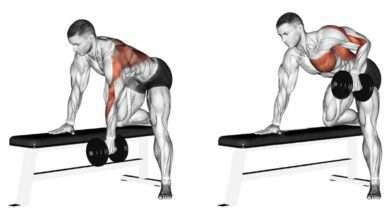The Best Essential Strength Training for Triathletes
Triathletes are used to pushing themselves to the utmost in their running, cycling, and swimming events, yet strength training’s advantages are sometimes disregarded. In this guide, we’ll go into the world of strength training e for triathletes, explaining why it’s revolutionary and outlining essential workouts to improve your time.
Strength Training for Triathletes
Strength training isn’t confined to mere weightlifting; it’s a precision-crafted strategy to amplify muscle strength, power, and endurance. It surpasses conventional weightlifting norms with the sole purpose of elevating the holistic athletic prowess of triathletes. By refining their capabilities in swimming, cycling, and running, this method becomes a dynamic catalyst for overall performance enhancement.
The Importance of Strength Training in Triathlon
Triathlons demand more than cardiovascular fitness. Strength training is critical to performance enhancement, injury prevention, and general endurance improvement. Gaining weight is less vital than having a robust and resilient body that can withstand the demands of a triathlon.
Common Misconceptions
Before we plunge into exercise, let’s debunk a few misconceptions. Forget the notion that strength training will bulk you up; it’s not about turning into a powerhouse but a tactical approach to amplify your athletic prowess while safeguarding your endurance. Now, let’s delve into the intricacies of these benefits.
Benefits of Strength Training for Triathletes
Injury Prevention
Triathletes are susceptible to overuse injuries due to the repetitive nature of their training. Strength training for triathletes helps counteract this by building muscle around joints, providing added support, and reducing the risk of joint injuries.
Enhanced Endurance
Contrary to the misconception that strength training hampers endurance, it contributes to sustained energy levels. Well-conditioned muscles can endure prolonged exertion, a valuable asset in the gruelling demands of a triathlon.
Essential Strength Training for Triathletes
Leg Strength
To execute this move effectively, position your feet about shoulder-width apart. Visualize the action as settling back into an imaginary chair, lowering your body with control. Once you’ve descended, smoothly return to the initial stance. This exercise focuses on engaging your quadriceps, hamstrings, and glutes, providing a comprehensive workout for these muscle groups.
Builds Lower Body Strength Crucial for Efficient Cycling and Running
Lunges
How-to: Step forward with one leg, lower your hips until both knees stand bent at a 90-degree angle, and return to the starting position. Targets individual legs, addressing imbalances and enhancing stability.
Core Strength
Planks
To master this manoeuvre, assume a push-up stance with your arms fully extended. Activate your core muscles, ensuring your body maintains a seamless straight line. This dynamic exercise fortifies your core and acts as a catalyst for refining posture and stability, fostering a solid foundation for overall strength and balance.
Russian Twisting’s
How-to: Sit on the ground, lean back slightly, and twist your torso, touching the ground on either side. Targets the obliques, enhancing rotational strength beneficial in swimming and cycling.
Upper Body Strength
Push-Ups
How-to: Lower your body by bending your elbows, then push back up from a plank position. It builds upper body strength, contributing to better arm endurance in swimming and maintaining an aerodynamic position on the bike.

Pull-Ups
How-to: Hang from a bar with palms facing away, pull your body upward until your chin clears the bar, then lower back down. Strengthens the back and arms, essential for maintaining form and power throughout the triathlon.
Incorporating Strength Training into Triathlon Training
Frequency and Timing
The frequency of Strength Training for Triathletes sessions depends on individual training plans, but 2-3 sessions per week during the off-season and 1-2 sessions during peak training phases are generally recommended.
Tailoring Workouts for Different Phases
Adapting strength training intensity and focus based on the specific phase of triathlon training—off-season, base training, and pre-competition ensures a well-rounded approach.
Overcoming Challenges Time Constraints
Triathletes often juggle busy schedules. Efficient strength workouts can be incorporated, focusing on combination exercises that simultaneously work for multiple muscle groups.
Balancing with Triathlon-Specific Training
Some may worry about potential conflicts between strength training and sport-specific skills. However, a well-designed program can enhance overall performance without compromising other aspects of training.
Adapting for Varied Skill Levels
Whether you’re a seasoned triathlete or just starting, strength training can be adapted to different skill levels. Beginners can start with bodyweight exercises, gradually progressing to more advanced movements.
Nutrition Tips for Triathletes
Importance of Balanced Diet
A well-rounded diet is crucial for triathletes. It provides the necessary fuel for training and supports overall health. Confirm that your plate is filled with a variety of nutrient-dense foods.
Protein Intake for Muscle Recovery
Triathletes engaged in strength training should pay extra attention to protein input. Protein is required for muscle recovery and growth. Include lean protein sources in your diet.
Hydration Strategies
Proper hydration is critical to sustaining performance and preventing fatigue during training and races. Develop a hydration plan that aligns with your individual needs and training intensity.
Monitoring Progress
Tracking Strength Gains
Jot down the details of your strength training endeavours; document the weights conquered and the repetitions conquered. This meticulous record-keeping isn’t just a task; it’s your roadmap to progress. By maintaining this insightful log, you open the door to a realm of adjustments, tailoring your future workouts with precision based on your unique journey and accomplishments.
Adjusting Workouts Accordingly
As your strength increases, adjusting your workouts to continue challenging your muscles is essential. This could involve increasing resistance, changing exercises, or altering the workout structure.
Seeking Professional Guidance
If you need more clarification about crafting a strength training plan or form, consider seeking guidance from a fitness professional. They can tailor a schedule to your specific needs and provide valuable insights.
Common Mistakes to Avoid
Overtraining
Optimize your triathlon journey by mastering critical strength training for triathletes while embracing the crucial art of rest. In the dynamic realm of triathlon training, heed the signals of overtraining fatigue’s lingering embrace, performance dips, and increased vulnerability to illness. Recognize that rest isn’t a mere pause but an essential partner in the intricate dance of preparation. Achieve the delicate balance through an artful understanding of your body’s cues, transforming each well-timed break into a strategic step toward peak performance and overall well-being. Uncover the transformative power of tailored strength training exercises, harmonizing intensity with the restorative art of recovery.
Neglecting Recovery
Recovery is as important as the workout itself. Ensure you incorporate rest days into your training schedule, prioritize sleep, and consider additional recovery strategies like massage or foam rolling.
Ignoring Individual Needs
Every triathlete is unique, and their training needs vary. Customize your strength training program to address individual weaknesses and goals, ensuring a personalized and practical approach.
Success Stories Strength Training for Triathletes
Testimonials from Triathletes
Real-life experiences of triathletes who have witnessed significant improvements through dedicated strength training. Their stories inspire others to embrace this crucial aspect of training.
Transformative Experiences
Stories of individuals who transformed their triathlon performance and overall fitness through incorporating strength training. These narratives highlight the holistic benefits of a well-rounded training approach.
Inspirational Journeys
Triathletes overcome challenges and achieve their goals with the support of strength training. These stories serve as a reminder that strength training is not just about physical gains but also mental resilience and determination.
Conclusion
Strength training unveils a trove of advantages for triathletes, weaving a tapestry beyond injury prevention. Picture it as a dynamic key, unlocking improved performance and endurance and sculpting a triathlete into a versatile, resilient force. It’s not an addition; it’s a seamless blending with traditional triathlon training to craft an athlete who thrives on the balance of strength and stamina.
FAQs
How often should triathletes engage in strength training?
Aim for at least two sessions per week, focusing on key muscle groups involved in swimming, cycling, and running.
What types of exercises are essential for triathletes?
Include compound movements like squats, deadlifts, and lunges, along with core exercises and sport-specific drills.
When is the best time to integrate strength training into a triathlon training plan?
Ideally, schedule strength sessions on non-endurance training days to allow for proper recovery.
Can bodyweight exercises be effective for triathletes?
Absolutely, bodyweight exercises are valuable for building functional strength and can be easily incorporated into training plans.











